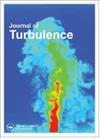Spatial-scaling method and modified large eddy simulation to examine rough-wall turbulence
IF 1.5
4区 工程技术
Q3 MECHANICS
引用次数: 0
Abstract
Direct numerical simulations of turbulent boundary layers with roughness elements on a wall were performed to investigate the spatial characteristics of rough-wall turbulence and establish a corresponding prediction method. When the roughness height was larger than the buffer layer, the rough-wall turbulence exhibited different spatial characteristics of the turbulence structures from those pertaining to a smooth wall. A novel spatial scaling method was established to examine the universal spatial characteristics of turbulence structures in the presence and absence of wall roughness. Specifically, the viscous length was determined by modifying the definition of the friction velocity in the region in which the roughness influenced the flow. The rough-wall turbulence could be accurately predicted by performing large eddy simulations using the subgrid scale model with the filter width, which was modified using the proposed spatial scaling method. The proposed model can be used to design more efficient fluid machinery in engineering applications.空间标度法与修正大涡模拟研究粗壁湍流
为了研究粗糙壁湍流的空间特性,建立了相应的预测方法,对壁面上带有粗糙单元的湍流边界层进行了直接数值模拟。当粗糙度高度大于缓冲层时,粗糙壁湍流表现出与光滑壁湍流结构不同的湍流结构空间特征。建立了一种新的空间尺度方法来检验在存在和不存在壁粗糙度的情况下湍流结构的普遍空间特征。具体而言,粘性长度是通过修改粗糙度影响流动的区域中摩擦速度的定义来确定的。粗壁湍流可以通过使用具有滤波器宽度的子网格尺度模型进行大涡模拟来准确预测,该模型使用所提出的空间尺度方法进行了修改。该模型可用于工程应用中设计更高效的流体机械。
本文章由计算机程序翻译,如有差异,请以英文原文为准。
求助全文
约1分钟内获得全文
求助全文
来源期刊

Journal of Turbulence
物理-力学
CiteScore
3.90
自引率
5.30%
发文量
23
审稿时长
6-12 weeks
期刊介绍:
Turbulence is a physical phenomenon occurring in most fluid flows, and is a major research topic at the cutting edge of science and technology. Journal of Turbulence ( JoT) is a digital forum for disseminating new theoretical, numerical and experimental knowledge aimed at understanding, predicting and controlling fluid turbulence.
JoT provides a common venue for communicating advances of fundamental and applied character across the many disciplines in which turbulence plays a vital role. Examples include turbulence arising in engineering fluid dynamics (aerodynamics and hydrodynamics, particulate and multi-phase flows, acoustics, hydraulics, combustion, aeroelasticity, transitional flows, turbo-machinery, heat transfer), geophysical fluid dynamics (environmental flows, oceanography, meteorology), in physics (magnetohydrodynamics and fusion, astrophysics, cryogenic and quantum fluids), and mathematics (turbulence from PDE’s, model systems). The multimedia capabilities offered by this electronic journal (including free colour images and video movies), provide a unique opportunity for disseminating turbulence research in visually impressive ways.
 求助内容:
求助内容: 应助结果提醒方式:
应助结果提醒方式:


